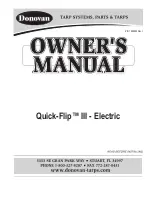
them. Refer to troubleshooting information in
Bendix service literature.
3.
Check for excessive leakage around the purge
valve with the compressor in the loaded mode
(compressing air). Apply a soap solution to the
purge valve exhaust port and observe that leak-
age does not exceed a 1-inch (25-mm) bubble in
1 second. If the leakage exceeds the maximum
specified, refer to troubleshooting information in
the Bendix service literature.
4.
Build system pressure to governor cutout, and
note that the dryer purges with an audible es-
cape of air. Fan the service brakes to reduce
system air pressure to governor cut-in. Note that
the system once again builds to full pressure and
is followed by a dryer purge. If the system does
not follow this pattern, refer to troubleshooting
information in the Bendix service literature.
5.
Check operation of the end cover heater and
thermostat assembly during cold weather, as fol-
lows:
5.1
Electric Power to the Dryer: With the igni-
tion or engine kill switch in the ON posi-
tion, check for voltage to the heater and
thermostat assembly using a voltmeter or
testlight. Unplug the electrical connector
at the air dryer and place the test leads
on each of the connections of the female
connector on the vehicle power lead. If
there is no voltage, look for a blown fuse,
broken wires, or corrosion in the vehicle
wiring harness. Check to see if a good
ground path exists.
5.2
Thermostat and Heater Assembly Opera-
tion: These tests are not possible except
in cold-weather operation. Turn off the
ignition switch, and cool the thermostat
and heater assembly to below 40°F
(4°C). Using an ohmmeter, check resis-
tance between the electrical pins in the
air dryer connector half. Resistance
should be 1.5 to 3.0 ohms for the 12-volt
heater assembly, and 6.0 to 9.0 ohms for
the 24-volt heater assembly.
NOTE: Some models of the AD-9 may
have a resistance reading of 1.0 to 2.5
ohms.
Warm the thermostat and heater assem-
bly to approximately 90°F (32°C) and
again check the resistance. Resistance
should exceed 1000 ohms. If resistance
values obtained are within stated limits,
the thermostat and heater assembly is
operating properly. If resistance values
obtained are outside stated limits, replace
the heater and thermostat assembly.
6.
On the AD-IS/dryer reservoir module (DRM) only,
observe the pressure gauges of the vehicle as
system pressure builds from zero. The primary
gauge should rise until it reaches approximately
109±5 psi (751±34 kPa), then level off (or a mo-
mentary slight fall) as the second pressure pro-
tection valve opens supplying the secondary res-
ervoir. When the secondary pressure gauge
passes through approximately 55±5 psi (379±34
kPa) and then 85±5 psi (586±34 kPa) there
should be an associated levelling off (or momen-
tary slight fall) of pressure as the third and fourth
pressure protection valves open. Finally, both the
primary and secondary gauges should reach
their full pressure of approximately 130±5 psi
(896±34 kPa). If the AD-IS does not perform
within the pressure ranges described above, re-
check using gauges known to be accurate. If
readings remain outside the ranges outlined
above, replace the AD-IS.
There are no kits available for servicing the pres-
sure protection valves.
WARNING
Do not attempt to adjust or service the pressure
protection valves. Incorrect pressure protection
valve settings can result in automatic application
of the vehicle spring brakes without prior warning.
This can cause personal injury or property dam-
age.
42–09 Brake Lines and Fittings
Inspection, Hydraulic
Brakes
Chock the tires, release park brake, and make a full-
service brake application.
Replace damaged or leaking components, and
tighten loose fittings.
Brakes
42
Business Class M2 Maintenance Manual, November 2015
42/9
Property of American Airlines






































